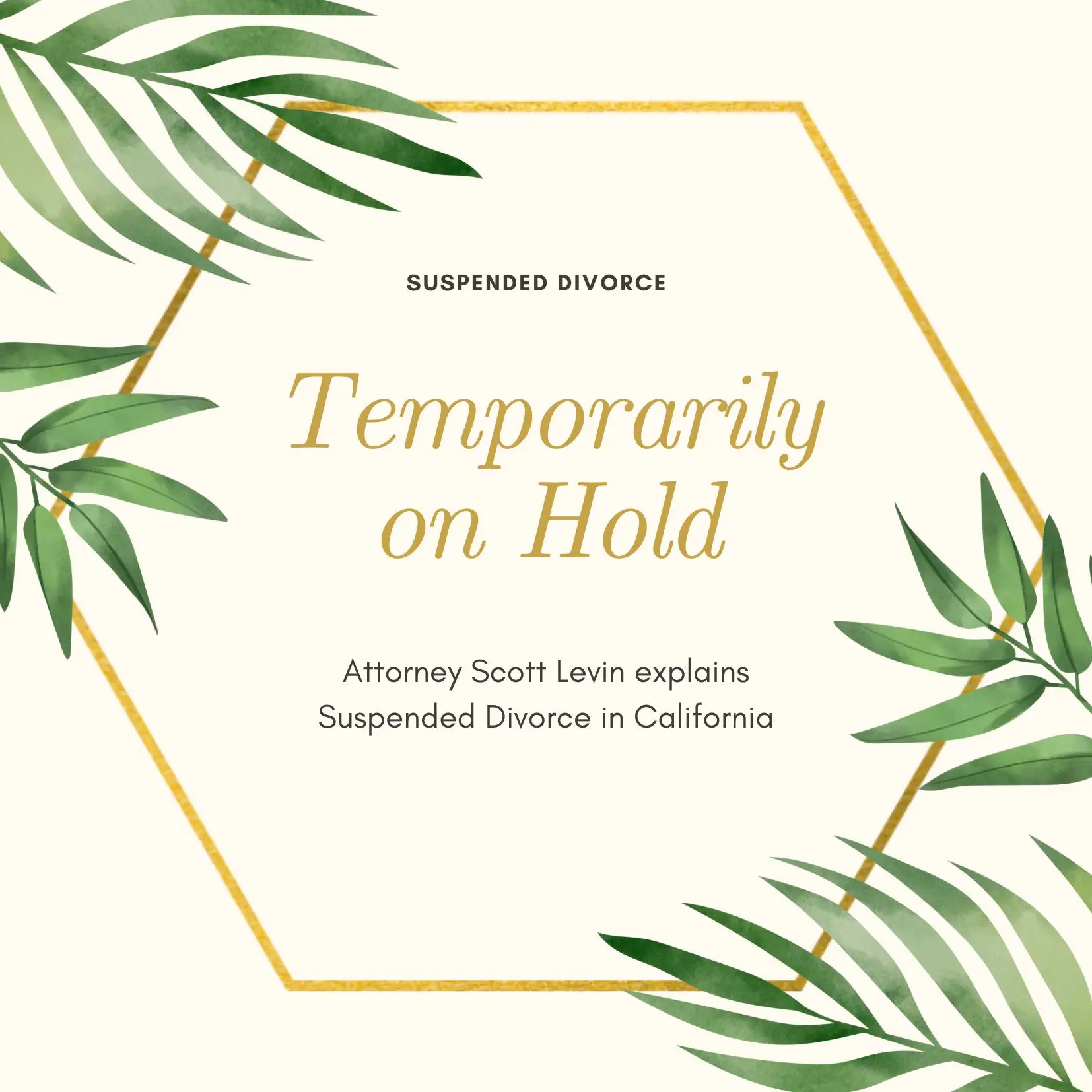Popular Tags

California Suspended Divorce Lawyer
California Family Law: Suspended Divorce Explained
Divorce is often seen as a definitive end to a marriage, but in California, there’s a lesser-known option that allows couples to navigate separation while maintaining certain legal benefits of marriage. This approach is known as a “suspended divorce.”
In essence, a suspended divorce is a normal divorce proceeding in California where the couple chooses to “suspend” the termination of their marital status. This means that while a judgment of divorce is entered, the couple remains legally married.
This unique legal arrangement can offer significant advantages for some couples, particularly in terms of financial benefits and healthcare coverage. However, there are important limitations and things to think about before deciding if it’s the best choice for a couple.
Legal Separation Alternative for Ongoing Joint Tax Filings and Health Insurance
What is a Suspended Divorce?
A suspended divorce in California is a legal process that allows a couple to go through the typical process and to complete the steps of a traditional divorce. This means a couple will reach settlement terms on the issues of divorce including property division, child custody arrangements, and child and spousal support determinations. However, with a suspended divorce, a couple will remain married for a period of time and therefore will not actually terminate their marital status.
The key difference lies in the final step: instead of the court issuing a judgment that dissolves the marriage, the termination of marital status is suspended.
This means that in the eyes of the law, the couple remains married even though they have a court-approved agreement that settles all the typical issues addressed in a California divorce process. Not only do they have an agreement, but there is also a judgment of dissolution entered by the Court which means the Court is able to enforce the terms of the divorce agreement.
To get this question out of the way early on here – a suspended divorce is not the same as a legal separation. Legal separation in California is a distinct legal status in California and not synonymous with a suspended divorce.
Benefits of a Suspended Divorce
One of the primary reasons couples might opt for a suspended divorce is the potential tax benefits. By remaining legally married, the couple can continue to file their taxes jointly. This can be particularly advantageous if:
● One spouse earns significantly more than the other
● The couple has substantial deductions that are more beneficial when filing jointly
● There are tax credits that phase out at lower income levels for single filers
It’s important to consult with a tax professional to fully understand the potential tax implications and benefits in your specific situation.
Another significant benefit of a suspended divorce is the ability to maintain health insurance coverage. In many cases, when a divorce is finalized, a spouse who was covered under their partner’s employer-sponsored health insurance plan loses that coverage. This can be particularly problematic if the dependent spouse has pre-existing conditions or limited access to affordable alternative coverage.
With a suspended divorce, because the couple remains legally married, they can often continue to share health insurance benefits. This can provide crucial financial and health security, especially if one spouse has ongoing medical needs or limited employment options with health benefits.
For couples who have been married for a long time, particularly those approaching retirement age, a suspended divorce can help preserve certain Social Security benefits. Under current laws, if a marriage lasted at least 10 years, a divorced spouse may be eligible for benefits based on their ex-spouse’s work record. By suspending the divorce, couples who are close to but haven’t yet reached the 10-year mark can ensure they meet this threshold.
Legal Process for a Suspended Divorce
The process for obtaining a suspended divorce in California is similar to a standard divorce proceeding, with a few key differences:
- Filing for Divorce: One spouse files a petition for divorce, just as in a standard divorce case.
- Negotiation and Agreement: The couple works out agreements on all typical divorce issues, including property division, child custody, and support.
- Court Approval: The agreements are submitted to the court for approval.
- Judgment Entry: Instead of a judgment dissolving the marriage, the court enters a judgment that includes all the agreed-upon terms but specifies that the termination of marital status is suspended.
- Ongoing Status: The couple remains legally married but lives according to the terms set out in the divorce judgment.
Working with a divorce lawyer who has experience with suspended divorces is important. Hiring a divorce lawyer who knows about suspended divorces is best as this will ensure that all legal requirements are followed, and that the judgment clearly states the desired delay to the marital end.
For couples considering a suspended divorce, it’s worth exploring the process options for achieving the suspended divorce in California:
- Collaborative Divorce: This process involves working with attorneys and other professionals to reach a settlement outside of court, which could potentially include agreements that address some of the concerns that might lead couples to consider a suspended divorce.
- Mediation: Working with a neutral third party to negotiate the terms of a divorce can sometimes lead to creative solutions that ad
Who Might Consider a Suspended Divorce?
A suspended divorce isn’t suitable for everyone, but it might be worth considering for couples who:
● Want to maintain certain financial benefits of marriage, such as tax advantages or health insurance coverage
● Are close to reaching the 10-year mark for Social Security benefit eligibility
● Are uncertain about permanently ending their marriage but want to live separately with clear agreements in place
● Have unique financial or health circumstances that make maintaining marital status beneficial
Legal Separation vs Suspended Divorce
For couples considering a suspended divorce, it’s worth exploring other options to ensure they’re making the best choice for their situation:
- Legal Separation: This allows couples to live apart and have court orders regarding property, support, and child custody, while remaining married. Unlike a suspended divorce, there’s no divorce judgment entered.
- Traditional Divorce: For many couples, a standard divorce proceeding may still be the best option, especially if either party may want to remarry in the future.
Contact San Diego Mediation Divorce & Family Law to Learn More
A suspended divorce in California is a unique option for ending a marriage. It can save couples money and allow them to maintain healthcare benefits. However, it also comes with important limitations and potential complications that must be carefully considered.
If you’re contemplating a suspended divorce, it’s wise to consult with an experienced family law attorney who can guide you through the process and help you understand whether this option aligns with your specific circumstances and long-term goals. Additionally, seeking advice from a financial advisor and tax professional can provide valuable insights into the financial implications of this decision.
Remember, while a suspended divorce can offer certain advantages, it’s not a one-size-fits-all solution. Each couple’s situation is unique, and what works for one may not be the best choice for another. By thoroughly exploring all options and seeking professional guidance, you can make an informed decision that best serves your interests and those of your family. Call us at (858) 255-1321 or contact us online to learn more about your options.



















